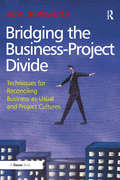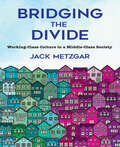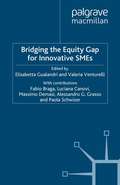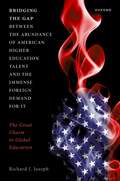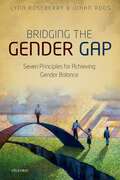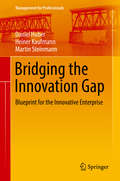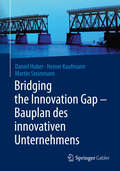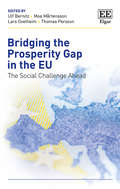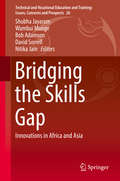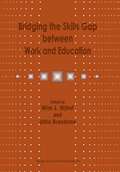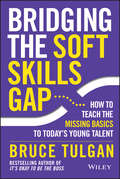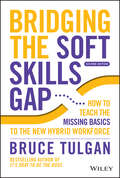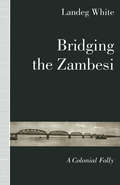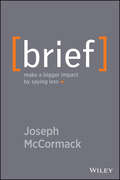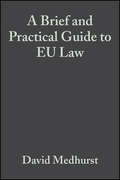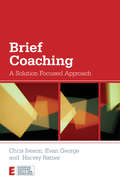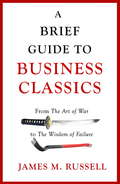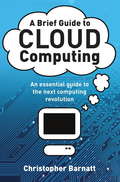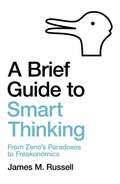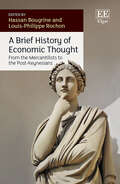- Table View
- List View
Bridging the Business-Project Divide: Techniques for Reconciling Business-as-Usual and Project Cultures
by John BrinkworthIn organizations these days, there are two cultures, two sets of expectations, two languages; that of the business-as-usual organization and separately that of projects. These cultures need to work together effectively. Unfortunately, the natural side-effect of two such different perspectives is misunderstanding, mutual incomprehension, and despite good intentions on both sides, failure to deliver desired benefits. In Bridging the Business-Project Divide John Brinkworth tackles these issues by examining: ·
Bridging the Divide: Working-Class Culture in a Middle-Class Society
by Jack MetzgarIn Bridging the Divide, Jack Metzgar attempts to determine the differences between working-class and middle-class cultures in the United States. Drawing on a wide range of multidisciplinary sources, Metzgar writes as a now middle-class professional with a working-class upbringing, explaining the various ways the two cultures conflict and complement each other, illustrated by his own lived experiences.Set in a historical framework that reflects on how both class cultures developed, adapted, and survived through decades of historical circumstances, Metzgar challenges professional middle-class views of both the working-class and themselves. In the end, he argues for the creation of a cross-class coalition of what he calls "standard-issue professionals" with both hard-living and settled-living working people and outlines some policies that could help promote such a unification if the two groups had a better understanding of their differences and how to use those differences to their advantage. Bridging the Divide mixes personal stories and theoretical concepts to give us a compelling look inside the current complex position of the working-class in American culture and a view of what it could be in the future.
Bridging the Equity Gap for Innovative SMEs (Palgrave Macmillan Studies in Banking and Financial Institutions)
by E. Gualandri V. VenturelliExplores the idea that Europe's growth problems may be caused by weaknesses in capital markets and in the access to risk capital. It addresses the evaluation of the financial needs and constraints of start-up firms and how these might be bridged. The role of public sector intervention is analyzed, focusing on international best practices.
Bridging the Gap between the Abundance of American Higher Education Talent and the Immense Foreign Demand for It: The Great Chasm in Global Education
by Richard J. JosephThe gap between the abundance of American higher education talent and the immense foreign demand for it is the great chasm in global education. It is a gulf of lost opportunities. It is also a space of great economic potential. This book describes the great chasm, examines factors underlying it, and suggests ways to bridge the gap to realize this potential. The abundance of talent stems from the slackening growth of the U.S. higher education sector in the New Millennium. Contributing to the slowdown are flat enrollments, adverse demographic trends, U.S. visa restrictions, and intensifying competition. The immense foreign demand has been fueled by the secular expansion of the global economy. It has been shaped by the pressing need in emerging markets to develop an educated workforce. The great chasm creates an opportunity for American academic institutions to extend their global reach. Bridging the gap, however, is not an easy feat for most U.S. colleges and universities. It is complicated by an institutional culture that is averse to commercialization, an organizational structure that is operationally slow, and a governance system that often leads to indecision, conflict, and paralysis. Bridging the gap requires fundamental changes in the culture, organization, and governance of traditional U.S. academic institutions. These changes will pave the way for international expansion, which could enhance the financial well-being of these institutions, the social-well-being of less developed nations, and the critical role that America plays globally in knowledge creation, the dissemination of ideas, and the pursuit of the truth.
Bridging the Gap between the Abundance of American Higher Education Talent and the Immense Foreign Demand for It: The Great Chasm in Global Education
by Richard J. JosephThe gap between the abundance of American higher education talent and the immense foreign demand for it is the great chasm in global education. It is a gulf of lost opportunities. It is also a space of great economic potential. This book describes the great chasm, examines factors underlying it, and suggests ways to bridge the gap to realize this potential. The abundance of talent stems from the slackening growth of the U.S. higher education sector in the New Millennium. Contributing to the slowdown are flat enrollments, adverse demographic trends, U.S. visa restrictions, and intensifying competition. The immense foreign demand has been fueled by the secular expansion of the global economy. It has been shaped by the pressing need in emerging markets to develop an educated workforce. The great chasm creates an opportunity for American academic institutions to extend their global reach. Bridging the gap, however, is not an easy feat for most U.S. colleges and universities. It is complicated by an institutional culture that is averse to commercialization, an organizational structure that is operationally slow, and a governance system that often leads to indecision, conflict, and paralysis. Bridging the gap requires fundamental changes in the culture, organization, and governance of traditional U.S. academic institutions. These changes will pave the way for international expansion, which could enhance the financial well-being of these institutions, the social-well-being of less developed nations, and the critical role that America plays globally in knowledge creation, the dissemination of ideas, and the pursuit of the truth.
Bridging the Gender Gap: Seven Principles for Achieving Gender Balance
by Lynn Roseberry Johan RoosDespite decades of efforts to promote gender equality, most leadership positions in business, politics, education, and even NGOs are occupied by men, and most people still work in occupations dominated by one sex. This book argues that gender imbalances in leadership and occupations are not simply a moral issue or an economic issue, but a governance issue. Gender imbalances persist in large part because the very people with the authority and influence to do something about them know very little about gender and how it works in their organizations and in society at large. Gender imbalanced governance is an expression of entrenched ideas about masculinity and femininity that lead to poor decision making. Improving the quality of governance requires action to counteract the main justifications for the status quo. Based on interviews and conversations with leaders and managers in Europe and the United States, the book presents seven of the most common explanations for persistent gender imbalances and shows how they are based on common stereotypes and myths about men's and women's abilities and preferences. This book provides a guided tour of current research about gender from a multi-disciplinary perspective. It challenges commonly held assumptions and offers alternative explanations and corresponding principles to guide individual decisions, action, and behaviour toward achieving gender balance.
Bridging the Innovation Gap: Blueprint for the Innovative Enterprise (Management for Professionals)
by Daniel Huber Heiner Kaufmann Martin SteinmannThis book offers fresh insights into innovation management and its prerequisites. Based on these insights, the authors present a new and proven innovation system, which is being used in practice and has the potential to significantly increase the ability of enterprises to innovate. Starting with the innovation dilemma that enterprises face, the book analyses the concept of innovation as it is (mis)understood in practice, and identifies the missing element in current innovation theories - the innovation gap. Further, it asks whether today's enterprises are well suited for innovation and then describes a solution to the problems identified. The book also introduces a new and important element of the revised innovation process called “Exploration”. From leadership issues to building a strong innovation model, it offers state-of-the-art knowledge, which can significantly boost the chances of innovation succeeding in enterprises.
Bridging the Innovation Gap - Bauplan des innovativen Unternehmens: Blueprint For The Innovative Enterprise (Management For Professionals Ser.)
by Daniel Huber Heiner Kaufmann Martin SteinmannInnovation wird zunehmend zum wichtigsten Erfolgsfaktor von Unternehmen. Die etablierten Innovationssysteme funktionieren allerdings vielerorts nicht. Zahlreiche Innovationsvorhaben scheitern aus nicht erklärbaren Gründen. Basierend auf ihrer langjährigen industriellen Praxis identifizieren die Autoren Lücken und Irrtümer im bisherigen Verständnis des Innovationsvorgangs und stellen erstmals ein funktionierendes und durchgängiges Innovationssystem vor. Dieses wegweisende „Berner Innovationsmodell“ überbrückt den „Innovation Gap“ und hat das Potenzial, Unternehmen zu nachhaltigem Erfolg zu führen.
Bridging the Prosperity Gap in the EU: The Social Challenge Ahead
by Ulf Bernitz Moa Mårtensson Lars Oxelheim Thomas PerssonBridging the Prosperity Gap in the EU addresses the great social challenge currently facing the European Union. Taking an interdisciplinary approach, the authors invaluably pinpoint both overarching problems and possibilities associated with the social dimension of European integration. Prominent researchers of economics, law and political science tackle this complex issue, providing new solutions within their respective fields of expertise. The chapters cover crucial policy challenges and analyse fundamental mechanisms that limit, or otherwise affect, the evolution of a European social dimension. These insights clarify the far-reaching measures that will be needed to gradually restore the balance between market integration and social protection across the European Union. Illustrating the importance of cohesion, this book is vital for those interested in comparative European studies, from backgrounds in public and social policy, law and economics.
Bridging the Skills Gap: Innovations In Africa And Asia (Technical And Vocational Education And Training: Issues, Concerns And Prospects Ser. #26)
by Shubha Jayaram Wambui Munge Bob Adamson David Sorrell Nitika JainThis volume seeks to examine the skills development agenda for youth by exploring two key questions for sustainable livelihoods: What are the skills needed for employability in developing countries, especially in Africa and Asia? And, what skills are currently possessed by students and secondary school leavers? An introductory chapter will set the stage for the discussion and analysis to follow by reviewing in broad terms the current research on relevant topics such as global youth unemployment, the relationship between skills and economic growth, and the expansion of secondary education. The following chapters synthesize a series of background studies focused on Africa, South Asia and South-East Asia, including both a general overview and an in-depth look at several countries. The chapters introduce innovative models for skills delivery, and highlight some of the key elements of successful skills models, including multi-stakeholder partnerships, updated pedagogy, and innovative financing mechanisms. Each of the five core chapters of the book covers one theme, with the support of case studies to illustrate successes, challenges, and lessons in real world examples.
Bridging the Skills Gap between Work and Education
by Wim J. Nijhof Jittie BrandsmaThis book takes up the debate about matching vocational education with the labour market and shows progress in terms of theoretical models, tools (transformation and matching processes), and learning environments. The solutions, showing up the need for core or key skills, the necessity of embedding learning skills in authentic and guided learning environments, shows a perspective of research and developmen-tal work to be tested in schools and in workplaces, to find better curricula for a better skilling.
Bridging the Soft Skills Gap: How to Teach the Missing Basics to Todays Young Talent
by Bruce TulganSolve the number one problem with today's young workforce—the soft skills gap The number one challenge with today's young talent is a problem hiding in plain sight: the ever-widening soft skills gap. Today's new, young workforce has so much to offer—new technical skills, new ideas, new perspective, new energy. Yet too many of them are held back because of their weak soft skills. Soft skills may be harder to define and measure than hard skills, but they are just as critical. People get hired because of their hard skills but get fired because of their soft skills. Setting a good example or simply telling young workers they need to improve isn't enough, nor is scolding them or pointing out their failings in an annual review. However you can teach the missing basics to today's young talent. Based on more than twenty years of research, Bruce Tulgan, renowned expert on the millennial workforce, offers concrete solutions to help managers teach the missing basics of professionalism, critical thinking, and followership—complete with ninety-two step-by-step lesson plans designed to be highly flexible and easy to use. Tulgan's research and proven approach has show that the key to teaching young people the missing soft skills lies in breaking down critical soft skills into their component parts, concentrating on one small component at a time, with the help of a teaching-style manager. Almost all of the exercises can be done in less than an hour within a team meeting or an extended one-on-one. The exercises are easily modified and customized and can be used as take-home exercises for any individual or group, to guide one-on-one discussions with direct-reports and in the classroom as written exercises or group discussions. Managers—and their young employees—will find themselves returning to their favorite exercises over and over again. One exercise at a time, managers will build up the most important soft skills of their new, young talent. These critical soft skills can make the difference between mediocre and good, between good and great, between great and one of a kind.
Bridging the Soft Skills Gap: How to Teach the Missing Basics to Todays Young Talent
by Bruce TulganSolve the number one problem with today's young workforce—the soft skills gap The number one challenge with today's young talent is a problem hiding in plain sight: the ever-widening soft skills gap. Today's new, young workforce has so much to offer—new technical skills, new ideas, new perspective, new energy. Yet too many of them are held back because of their weak soft skills. Soft skills may be harder to define and measure than hard skills, but they are just as critical. People get hired because of their hard skills but get fired because of their soft skills. Setting a good example or simply telling young workers they need to improve isn't enough, nor is scolding them or pointing out their failings in an annual review. However you can teach the missing basics to today's young talent. Based on more than twenty years of research, Bruce Tulgan, renowned expert on the millennial workforce, offers concrete solutions to help managers teach the missing basics of professionalism, critical thinking, and followership—complete with ninety-two step-by-step lesson plans designed to be highly flexible and easy to use. Tulgan's research and proven approach has show that the key to teaching young people the missing soft skills lies in breaking down critical soft skills into their component parts, concentrating on one small component at a time, with the help of a teaching-style manager. Almost all of the exercises can be done in less than an hour within a team meeting or an extended one-on-one. The exercises are easily modified and customized and can be used as take-home exercises for any individual or group, to guide one-on-one discussions with direct-reports and in the classroom as written exercises or group discussions. Managers—and their young employees—will find themselves returning to their favorite exercises over and over again. One exercise at a time, managers will build up the most important soft skills of their new, young talent. These critical soft skills can make the difference between mediocre and good, between good and great, between great and one of a kind.
Bridging the Soft Skills Gap: How to Teach the Missing Basics to the New Hybrid Workforce
by Bruce TulganNurture and develop well-rounded team players by focusing on soft skills development People entering the professional world are better educated than ever before. Their technical skills are often off-the-charts, helping them make short work of even the most challenging tasks. At the same time, however, many of these very same people lack soft skills we&’ve often taken for granted. In the newly revised second edition of Bridging the Soft Skills Gap: How to Teach the Missing Basics to the New Hybrid Workforce, veteran business advisor, speaker, and consultant Bruce Tulgan delivers a practical and incisive roadmap to developing crucial professionalism, critical thinking, and teamwork skills. You&’ll also find: A collection of 92 instructive lesson plans designed to break soft skills down into their component parts and teach them one manageable piece at a time An exploration of the soft skills gap, including what it means and how its impact on your organization will be felt Explanations of why you can&’t hire your way around a soft skills gapAn essential leadership handbook for executives, managers, and other business leaders, Bridging the Soft Skills Gap is a must-read resource for human resources professionals, team leaders, and front-line employees who deal with promising, but unpolished, talent.
Bridging the Soft Skills Gap: How to Teach the Missing Basics to the New Hybrid Workforce
by Bruce TulganNurture and develop well-rounded team players by focusing on soft skills development People entering the professional world are better educated than ever before. Their technical skills are often off-the-charts, helping them make short work of even the most challenging tasks. At the same time, however, many of these very same people lack soft skills we&’ve often taken for granted. In the newly revised second edition of Bridging the Soft Skills Gap: How to Teach the Missing Basics to the New Hybrid Workforce, veteran business advisor, speaker, and consultant Bruce Tulgan delivers a practical and incisive roadmap to developing crucial professionalism, critical thinking, and teamwork skills. You&’ll also find: A collection of 92 instructive lesson plans designed to break soft skills down into their component parts and teach them one manageable piece at a time An exploration of the soft skills gap, including what it means and how its impact on your organization will be felt Explanations of why you can&’t hire your way around a soft skills gapAn essential leadership handbook for executives, managers, and other business leaders, Bridging the Soft Skills Gap is a must-read resource for human resources professionals, team leaders, and front-line employees who deal with promising, but unpolished, talent.
Bridging the Zambesi: A Colonial Folly
by Landeg WhiteIn 1935, a bridge was opened across the Zambesi delta in Portuguese East Africa. 51 years later, it was blown up by anti-government forces. This book brings together politics, diplomacy, economics, labour history and technology to show how this engineering feat was a disaster of colonial planning.
Brief: Make a Bigger Impact by Saying Less
by Joseph McCormackGet heard by being clear and concise The only way to survive in business today is to be a lean communicator. Busy executives expect you to respect and manage their time more effectively than ever. You need to do the groundwork to make your message tight and to the point. The average professional receives 304 emails per week and checks their smartphones 36 times an hour and 38 hours a week. This inattention has spread to every part of life. The average attention span has shrunk from 12 seconds in 2000 to eight in 2012. So, throw them a lifeline and be brief. Author Joe McCormack tackles the challenges of inattention, interruptions, and impatience that every professional faces. His proven B.R.I.E.F. approach, which stands for Background, Relevance, Information, Ending, and Follow up, helps simplify and clarify complex communication. BRIEF will help you summarize lengthy information, tell a short story, harness the power of infographics and videos, and turn monologue presentations into controlled conversations. Details the B.R.I.E.F. approach to distilling your message into a brief presentation Written by the founder and CEO of Sheffield Marketing Partners, which specializes in message and narrative development, who is also a recognized expert in Narrative Mapping, a technique that helps clients achieve a clearer and more concise message Long story short: BRIEF will help you gain the muscle you need to eliminate wasteful words and stand out from the rest. Be better. Be brief.
Brief: Make a Bigger Impact by Saying Less
by Joseph McCormackGet heard by being clear and concise The only way to survive in business today is to be a lean communicator. Busy executives expect you to respect and manage their time more effectively than ever. You need to do the groundwork to make your message tight and to the point. The average professional receives 304 emails per week and checks their smartphones 36 times an hour and 38 hours a week. This inattention has spread to every part of life. The average attention span has shrunk from 12 seconds in 2000 to eight in 2012. So, throw them a lifeline and be brief. Author Joe McCormack tackles the challenges of inattention, interruptions, and impatience that every professional faces. His proven B.R.I.E.F. approach, which stands for Background, Relevance, Information, Ending, and Follow up, helps simplify and clarify complex communication. BRIEF will help you summarize lengthy information, tell a short story, harness the power of infographics and videos, and turn monologue presentations into controlled conversations. Details the B.R.I.E.F. approach to distilling your message into a brief presentation Written by the founder and CEO of Sheffield Marketing Partners, which specializes in message and narrative development, who is also a recognized expert in Narrative Mapping, a technique that helps clients achieve a clearer and more concise message Long story short: BRIEF will help you gain the muscle you need to eliminate wasteful words and stand out from the rest. Be better. Be brief.
A Brief and Practical Guide to EU Law
by David MedhurstThis book is designed to be a quick guide to European Union law and explains how it may be used for practical effect. It is written in a clear style for practitioners who are in a hurry to master the subject, and contains precedents of the kinds of documents they may have to prepare. It explains the basic law, the basic concepts, the procedure and the jargon in a way that lawyers new to the subject will find easy to understand. It will give them the answers they need fast. Throughout, there is extensive reference to case law. The new edition has been revised to take into account the 1997 Amsterdam Treaty, which consolidated and renumbered the articles of the Union Treaty and incorporated the Social Charter. It also covers recent case law and changes to competition law.
Brief Coaching: A Solution Focused Approach (Essential Coaching Skills and Knowledge)
by Chris Iveson Evan George Harvey RatnerBrief Coaching offers a new approach to coaching by considering how the client will know when they have reached their goal, and what they are already doing to get there. The coach aims to work towards the solution rather than working away from the problem, so that the client's problem is not central to the session, but instead the coach and the client work towards the client's preferred future. This book employs case examples and transcripts of sessions to offer guidance on: looking for resources rather than deficits exploring possible and preferred futures examining what is already contributing to that future treating clients as experts in all aspects of their lives. This practical guide includes summaries and activities for the coach to do with the client and will therefore be a useful tool for both new and experienced coaches, as well as therapists branching into coaching who want to add to their existing skills.
Brief Coaching: A Solution Focused Approach (Essential Coaching Skills and Knowledge)
by Chris Iveson Evan George Harvey RatnerBrief Coaching offers a new approach to coaching by considering how the client will know when they have reached their goal, and what they are already doing to get there. The coach aims to work towards the solution rather than working away from the problem, so that the client's problem is not central to the session, but instead the coach and the client work towards the client's preferred future. This book employs case examples and transcripts of sessions to offer guidance on: looking for resources rather than deficits exploring possible and preferred futures examining what is already contributing to that future treating clients as experts in all aspects of their lives. This practical guide includes summaries and activities for the coach to do with the client and will therefore be a useful tool for both new and experienced coaches, as well as therapists branching into coaching who want to add to their existing skills.
A Brief Guide to Business Classics: From The Art of War to The Wisdom of Failure
by James M. RussellThe world of business books is a curious place where one can find everyone from great businesspeople like Warren Buffett, Steve Jobs and Elon Musk, to the most spectacular business failures such as Enron and the sub-prime business market. There are geniuses, hard workers, academics and entrepreneurs as well a few charlatans and hucksters. There's even room for Donald Trump. The 70 titles covered were chosen with various parameters in mind: to cover a range of areas of business, from sales and marketing to negotiation, entrepreneurship to investing, leadership to innovation, and from traditional and corporate models of business to start-up manuals and alternative angles on the subject. Obvious bestselling titles such as How to Make Friends and Influence People or 7 Habits of Highly Effective People have been included, but there are also those books of more questionable value often included on recommended lists of business classics, included here by way of warning. The chosen books also cover a wide span of time and acknowledge that some of the most powerful or entertaining insights into business can be found in texts that aren't perceived as being 'business books', for instance The Art of War, Microserfs, Thinking Fast and Slow and The Wealth of Nations. The selection includes a good range of the most recent successes in business publishing with which readers may be less familiar. The titles are arranged chronologically, allowing the reader to dip in, but also casting an intriguing light on how trends in business titles have changed over the years. Among these titles, you will find expert advice, based on solid research (for instance The Effective Executive or Getting to Yes), and inspirational guides to setting up businesses and running them on sound foundations (such as True North, Crucial Conversations, or We) alongside dubious management manuals that take a single flawed idea and stretch it out to the point of absurdity. The hope is that the reader will be inspired to read the best of these titles, ignore the worst of them, and will come away with at least a basic idea of what each has to teach us about business.
A Brief Guide to Cloud Computing: An essential guide to the next computing revolution. (Brief Histories)
by Christopher BarnattAn accessible and comprehensive guide to the future of computing.Cloud Computing is the next computing revolution and will have as much impact on your life as the introduction of the PC. Using websites including Facebook, Flickr and Gmail, many people already store some information out in the Internet cloud. However, within a few years most computing applications will be accessed online with the web at the heart of everything we do.In this valuable guide, expert Christopher Barnatt explains how computing will rapidly become more reliable, less complex, and more environmentally friendly. He explores online software and hardware, and how it will alter our office work and personal lives. Individuals and companies are going to be released from the constraints of desktop computing and expensive corporate data centres. New services like augmented reality will also become available.Including coverage of Google Docs, Zoho, Microsoft Azure, Amazon EC2 and other key developments, this book is your essential guide to the cloud computing revolution.
A Brief Guide to Smart Thinking: From Zeno’s Paradoxes to Freakonomics
by James M. RussellEach book is summarised to convey a brief idea of what each one has to offer the interested reader, while a 'Speed Read' for each book delivers a quick sense of what each book is like to read and a highly compressed summary of the main points of the book in question. The titles covered include thought-provoking classics on psychology, mindfulness, rationality, the brain, mathematical and economic thought and practical philosophy. The selection includes books about self-improvement as well as historically interesting accounts of how the mind works. Titles included go back as far as the Epictetus classic The Enchiridion and Bertrand Russell's charming The ABC of Relativity, and proceed through classics such as Edward de Bono's Lateral Thinking and into the digital era with titles such as The Shallows and Big Data. The books are arranged chronologically, which draws attention to some of the interesting juxtapositions and connections between them. Some of the titles included are: Freakonomics, by Steven D. Levitt; Blink: The Power of Thinking Without Thinking, by Malcolm Gladwell; Sapiens: A Brief History of Humankind, by Yuval Noah Harari; The Organized Mind: Thinking Straight in the Age of Information Overload, by Daniel J. Levitin; The Descent of Man, by Grayson Perry; How the Mind Works, by Steven Pinker; Black Box Thinking: Why Some People Never Learn from Their Mistakes - But Some Do, by Matthew Syed; We Should All Be Feminists, by Chimamanda Ngozi Adichie; Guns, Germs, and Steel: The Fates of Human Societies, by Jared Diamond; The Black Swan: The Impact of the Highly Improbable, by Nassim Nicholas Taleb; Man's Search for Meaning, by Viktor E. Frankl; The News: A User's Manual, by Alain de Botton; Mindware: Tools for Smart Thinking, by Richard E. Nisbett; The ABC of Relativity, by Bertrand Russell; The Psychopath Test, by Jon Ronson; The Path: What Chinese Philosophers Can Teach Us About the Good Life, by Michael Puett; A Brief History of Time, by Stephen Hawking; Messy: The Power of Disorder to Transform Our Lives, by Tim Harford; Big Data: A Revolution That Will Transform How We Live, Work, and Think, by Viktor Mayer-Schönberger; Moneyball: The Art of Winning an Unfair Game, by Michael Lewis; The Survivors Club: The Secrets and Science That Could Save Your Life, by Ben Sherwood; Black Box Thinking, by Matthew Syed; Chaos: Making a New Science, by James Gleick; A Short History of Nearly Everything, by Bill Bryson; The Shallows: What the Internet Is Doing to Our Brains, by Nicholas Carr; Making Ideas Happen: Overcoming the Obstacles Between Vision and Reality, by Scott Belsky; The Enchiridion, by Epictetus; Gödel, Escher, Bach, by Douglas R. Hofstadter; What I Talk About When I Talk About Running, by Haruki Murakami; and Lateral Thinking, by Edward de Bono.
A Brief History of Economic Thought: From the Mercantilists to the Post-Keynesians
It is now widely acknowledged that history is useful, even essential, because it helps us predict the future. The history of ideas in economics, as in other fields of inquiry, plays an important role in enlightening current researchers as they endeavour to understand contemporary events and anticipate the future of human societies. This book brings together a fine collection of chapters that span contributions from forgotten classics to the most recent new thinking about critical issues such as growth, wealth, its creation and its distribution among members of society. It is A Brief History of Economic Thought, but it will certainly go a long way in helping undergraduate students and other researchers who are curious about the evolution of economic ideas over the last five centuries. Chapters offer discussions on the main tenets of post-Keynesian economics, and focus on issues of growth, wealth and income distribution. The debate on the role of government versus the market is brought to the fore within the context of economic thought from the Physiocrats to the post-Keynesians.The editors have created an essential read for scholars and students interested in the history of economic thought and post-Keynesian economics.
